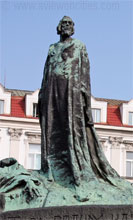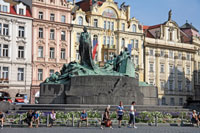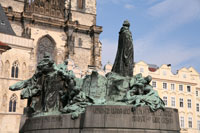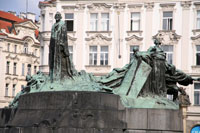Beggars All: Reformation And Apologetics: John Hus: They will roast a goose now (for ‘Huss’ means ‘a goose’), but after a hundred years they will hear a swan sing, and him they will endure:
WEDNESDAY, MARCH 03, 2010
John Hus: They will roast a goose now (for ‘Huss’ means ‘a goose’), but after a hundred years they will hear a swan sing, and him they will endure

Here's a typical account of the last moments of John Hus, before being burned by the Roman Catholic Council of Constance:
On July 6, 1415, as John Hus (whose name means "goose" in his native Czech) made his way to the place of execution, the authorities made him pass by a bonfire where his books were burning. Hus was unafraid and predicted the Protestant Reformation with almost uncanny accuracy. Some of his last words were: You are going to burn a goose but in a century you will have a swan which you can neither roast nor boil. [source]
This "Swan" of this statement has popularly been interpreted to be Martin Luther, not to mention, even by Luther himself:
However, I, Dr. Martinus, have been called to this work and was compelled to become a doctor, without any initiative of my own, but out of pure obedience. Then I had to accept the office of doctor and swear a vow to my most beloved Holy Scriptures that I would preach and teach them faithfully and purely. While engaged in this kind of teaching, the papacy crossed my path and wanted to hinder me in it. How it has fared is obvious to all, and it will fare still worse. It shall not hinder me. In God’s name and call I shall walk on the lion and the adder, and tread on the young lion and dragon with my feet. And this which has been begun during my lifetime will be completed after my death. St. John Huss prophesied of me when he wrote from his prison in Bohemia, “They will roast a goose now (for ‘Huss’ means ‘a goose’), but after a hundred years they will hear a swan sing, and him they will endure.” And that is the way it will be, if God wills. [LW 34:103]
I hadn't really thought much of the statement from Hus, other than the irony that indeed, a century later a lone monk began the Protestant Reformation. It's a popular quote. In my mind coincidence, nothing more. While reading in another area, I came across an article by Robert Scribner, Incombustible Luther: The Image of the Reformer in Early Modern Germany. Google Books offers a limited preview of this article with some missing pages, so I went ahead and ordered the book.
This is an incredibly interesting article. It documents the way that many turned Luther into a saint after his death. Stories circulated that paintings of him refused to burn. Luther's special saint miracle was hisincombustibility. The picture above in this entry is said to be a painting from 1689 that refused to burn, though it isn't certain. It's indeed the stuff of legends and fantasy. If you get a chance, read through Scribner's article, or at least what Google Books makes available. Note the similarities between the Luther myth and the typical Romanist saint myths.
Scribner's article takes an interesting look at a variety of the Luther legends, even those attributed to him while still living. Among those he covers is the quote from Hus:


A truly interesting find. Even Luther produced a botched quote, and did so to promote himself.
***
GJ - I thought the last sentence in the blog above was a bit dopey, but I left it in. The swan quotation is factually true, because Luther was accused of being a Hussite 102 years later. He studied the matter and agreed that he was indeed a Hussite (not a papist). For that reason Luther was still a man who deserved to be burned at the stake 13 years later, during the Diet of Augsburg. If anyone thinks that all the quotations floating around can be verified, syllable by syllable, with the right attribution - dream on. 'via Blog this'
 |
| The Council of Constance burned Hus at the stake. |
 |
| They do not put up statues to honor those who lit the fires. |
Rating
A colossal memorial on the Old Town Square commemorates Jan Hus, a 14th century religious reformer who challenged the opulence and corruption of the catholic church. The monument has become a symbol of Czech independence.

Jan Hus
Jan Hus
Jan Hus, born in 1369, was a protestant reformer who condemned the indulgence and corruption of the catholic church and the Vatican in particular. When the popularity of Hus gained strength, the catholic church excommunicated him. Hus wanted to defend his position at the Council of Constance but despite a letter of safe conduct from the emperor, he was imprisoned and declared a heretic. The following year, in 1415, he was burned at the stake.
Once news of his death reached Prague, people were indignated by the execution and considered it an attack on the nation. The followers of Jan Hus - known as Hussites - started to revolt and destroyed monasteries and churches. Pope Martin V called on the catholics in other countries to wage a war against the hussites, starting a long war between protestant hussites and catholic crusaders.
Once news of his death reached Prague, people were indignated by the execution and considered it an attack on the nation. The followers of Jan Hus - known as Hussites - started to revolt and destroyed monasteries and churches. Pope Martin V called on the catholics in other countries to wage a war against the hussites, starting a long war between protestant hussites and catholic crusaders.
Creation

The memorial honoring Jan Hus was the lifework of Czech sculptor Ladislav Šaloun, an autodidact who was inspired by the French sculptor Auguste Rodin. Šaloun started working on the sculpture in 1903, and the influence of the then-popular Jugendstil art movement is clearly visible.
 The monument was unveiled in 1915, on the 500th anniversary of the death of the reformer. At the time Prague was under Austrian rule, and the Habsburgs refused to officially inaugurate the monument. Locals covered the monument with flowers in protest. Ever since, it has been a symbol of opposition against foreign rule.
The monument was unveiled in 1915, on the 500th anniversary of the death of the reformer. At the time Prague was under Austrian rule, and the Habsburgs refused to officially inaugurate the monument. Locals covered the monument with flowers in protest. Ever since, it has been a symbol of opposition against foreign rule.

The Monument

A tall statue, rising high above a massive platform, shows the authoritative figure of Jan Hus. To his left are victorious Hussite troops, to his right are the oppressed protestants who were banished two hundred years later. The figure of a young mother symbolizes the resurgence of Czech nationalism.
An inscription on the base quotes the will of one of the followers of Hus, and contains a famous quote from Hus: 'Pravda Vitězí', meaning Truth Prevails. It is now an official motto, written on the banner of the President of the Czech Republic. The quote from Hus is even recognized as an official national symbol.
An inscription on the base quotes the will of one of the followers of Hus, and contains a famous quote from Hus: 'Pravda Vitězí', meaning Truth Prevails. It is now an official motto, written on the banner of the President of the Czech Republic. The quote from Hus is even recognized as an official national symbol.



